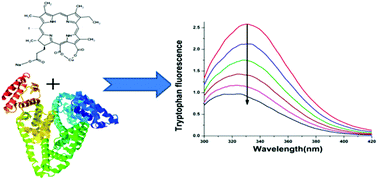Spectroscopic investigations on the binding of an iodinated chlorin p6-copper complex to human serum albumin
Abstract
The insertion of suitable metals or high Z elements in tumour-avid tetrapyrrole compounds is a promising approach to obtain potential agents for multimodal cancer therapeutics and tumour imaging. Using chlorin p6, a chlorophyll derivative, we synthesized a novel iodinated chlorin p6-copper complex (ICp6-Cu) that can be applied to the photodynamic therapy and photon activation therapy of cancer. In the present study, we investigated the interaction of ICp6-Cu with human serum albumin (HSA) using UV-Vis absorption and fluorescence spectroscopy. The addition of HSA to ICp6-Cu at physiological pH led to a ∼7 nm red shift in its Soret and Q band absorption. The binding constant (Kb) and the number of binding sites (n) of ICp6-Cu obtained from the quenching of the intrinsic fluorescence of HSA were 2.9 × 106 M−1 and 1.2 respectively. The distance between the Trp-214 residue and ICp6-Cu computed from Förster non-radiative energy transfer (FRET) theory was 3.1 nm. The emission of the ICp6-Cu fluorescence when excited at the protein’s Trp absorption (295 nm) further substantiated the FRET between the Trp residue and ICp6-Cu. Synchronous spectroscopy revealed that the quenching of protein Trp fluorescence was higher than that of Tyr with no significant shift in peak position. Results suggested that HSA acts as a carrier protein for ICp6-Cu with a high probability that the binding of ICp6-Cu occurred at subdomain IIA and the binding had no effect on the conformation of HSA.



 Please wait while we load your content...
Please wait while we load your content...